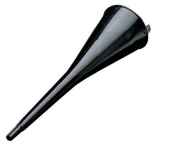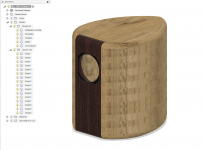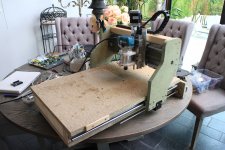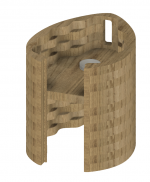Hi xrk971
I just herd your TABAQ (link in post #75). NICE !
Is Peerless WB 3.0 FR/08 "equal" to P830986 ?
Elias
I don't know what a Peerless WB 3.0FR/08 is other than 3in wide band 8 ohms? The P830986 is technically a 3.5in class driver in my mind, if that matters.
But the 830986 appears to be very similar in appearance to the OEM aluminum cone driver used in commercial TABAQ. It sounds the most impressive of all the 3.5in drivers I have heard on a MLTL.
I was thinking of using a pair of these for the full ranges?
You mean as a back "Dagger" style chamber to prevent coloration of mids? Yes, this would work quite well as a fullrange top in a FAST. It won't have any bass but that doesn't matter if XO is 300Hz or above.
From the looks of the commercial TABAQ, it seems to use a driver with an inverted surround. AKA - Peerless 830987??? 😀But the 830986 appears to be very similar in appearance to the OEM aluminum cone driver used in commercial TABAQ.
Last edited:
I don't know what a Peerless WB 3.0FR/08 is other than 3in wide band 8 ohms? The P830986 is technically a 3.5in class driver in my mind, if that matters.
But the 830986 appears to be very similar in appearance to the OEM aluminum cone driver used in commercial TABAQ. It sounds the most impressive of all the 3.5in drivers I have heard on a MLTL.
Hi xrk971
As for "Peerless WB 3.0FR/08
I found that at
Peerless WB 3.0 FR/08 - Fullrange kaufen bei hifisound.de
and as I opened the "PDF", data was for Peerless 830987.
The SPL graf for P830986 looks to my eyes more "flat" allthough not extended enough at the "high's" 12KHz
Elias
DCR Double Chamber Reflex - Calc port method?
Thanks XRK for helping me with my last project = I finished my jukebox 43" TV wall windows 7 insert with speaker designs based on all the great info from XRK and now I'm building a foam core Amazon DOT portable speaker based on DCR design of one third/ two third volume separator of a 2.5 liter trapezoid box. I bought 12 Panasonic TV units from PE for $2.50 each. They have a 3" and a 2". The 3" is in a 1 liter section with a .6 csa port 8.5" long. I'm taking the speakers out and putting the 3" in it's own DCR box but I'm confused about how to calculate the length of my .75" round ports. I have spent a lot of time researching and see there are two methods but they have different outcomes.
Take the whole vol of the box, (2.5 liters) and calculate the length using:
1. one port in the simulation then cut two more the same length. That comes out to be .55 inches long.
2. Or changing the simulation software to using "two" ports and that = 1.70 inches long then cut two more the same length.
I also think I saw someone just use the larger chamber with one port calculated and then cut two more the same length.
What method is the correct one?
thanks
Thanks XRK for helping me with my last project = I finished my jukebox 43" TV wall windows 7 insert with speaker designs based on all the great info from XRK and now I'm building a foam core Amazon DOT portable speaker based on DCR design of one third/ two third volume separator of a 2.5 liter trapezoid box. I bought 12 Panasonic TV units from PE for $2.50 each. They have a 3" and a 2". The 3" is in a 1 liter section with a .6 csa port 8.5" long. I'm taking the speakers out and putting the 3" in it's own DCR box but I'm confused about how to calculate the length of my .75" round ports. I have spent a lot of time researching and see there are two methods but they have different outcomes.
Take the whole vol of the box, (2.5 liters) and calculate the length using:
1. one port in the simulation then cut two more the same length. That comes out to be .55 inches long.
2. Or changing the simulation software to using "two" ports and that = 1.70 inches long then cut two more the same length.
I also think I saw someone just use the larger chamber with one port calculated and then cut two more the same length.
What method is the correct one?
thanks
You want to preserve the port cross sectional area and length when making multiple smaller ports to replace one big one. However, for narrow aspect ratio ports, the wall viscous drag is an important player and it won't scale properly. What software are you using to calculate a DCR? As far as I know, a true DCR cannot be simulated except using Akabak or another specialized program as they don't handle multiple chambers.
I used Unibox (excel) that does closed/vented/PR/bandpass. Based on the research I have done, I thought you could get close by determining the net speaker section volume (port, 1/2 port in separator wall, bracing and speaker vol) then take 1/2 of that for the vented section (add the vented port and 1/2 of the interconnecting port)- add the two together for the internal volume. Basically, make sure the net vol of each section is 1/3 and 2/3s.
Will need to tweak it a little as the port sizes are calculated.
3" driver specifications (measured in cabinet): Power handling: 15 watts RMS/30 watts max, Impedance: 6 ohms, Re: 4.75 ohms, Le: 0.83 mH, Frequency response (based on cabinet tuning): 80-4,000 Hz, Fs: 172 Hz, SPL: 85 dB 1W/1m, Qms: 4.05, Qes: 1.91, Qts: 1.30.
Since this is not high fidelity but a nice small amazon DOT portable system, I don't really need to be right on the money.
Based on your previous response, ("wall viscous drag") of smaller ports, would I increase or decrease the length a little?
Also, reading your post on your DCR, you mentioned that the interconnecting port was about .33 the length of the other ports to smooth the 150 hz area. Is that still your feeling?
However, without the correct simulator, I still need to know which method from my previous post, would be the correct way to determine the port lengths. Any ideas?
Thanks
Will need to tweak it a little as the port sizes are calculated.
3" driver specifications (measured in cabinet): Power handling: 15 watts RMS/30 watts max, Impedance: 6 ohms, Re: 4.75 ohms, Le: 0.83 mH, Frequency response (based on cabinet tuning): 80-4,000 Hz, Fs: 172 Hz, SPL: 85 dB 1W/1m, Qms: 4.05, Qes: 1.91, Qts: 1.30.
Since this is not high fidelity but a nice small amazon DOT portable system, I don't really need to be right on the money.
Based on your previous response, ("wall viscous drag") of smaller ports, would I increase or decrease the length a little?
Also, reading your post on your DCR, you mentioned that the interconnecting port was about .33 the length of the other ports to smooth the 150 hz area. Is that still your feeling?
However, without the correct simulator, I still need to know which method from my previous post, would be the correct way to determine the port lengths. Any ideas?
Thanks
Last edited:
That is nice - thank you - they are my last post. The 'net" vol of the main spk chamber is 96 cu in and the vented = 48 cu in = assuming three ports of .75 ID (1" OD) x 1.75 inc long and the interconnecting port is 1/2 in each chamber.
Thanks
Thanks
Oh I missed that as it was embedded in the paragraph. My eyes were scanning for a block of “code” with usual fs, Sd, Qms, Qes, etc.
Will give it a try and see what we come up with.
Will give it a try and see what we come up with.
THanks XRK,
No hurry as I won't be starting until the end of the week.
I wonder why there is confusion on the internet about how to calculate the ports?
scott
No hurry as I won't be starting until the end of the week.
I wonder why there is confusion on the internet about how to calculate the ports?
scott
@ xrk971
A long time ago I said I wanted to build one of these with more traditional materials, I havent built it yet but started drawing it up 🙂
Similar to wesaysos Twin Tower design and based on 19mm ply sheeting 😀
I have a DIY CNC in the basement which will do the main bulk of work for me
3D rendering:
A long time ago I said I wanted to build one of these with more traditional materials, I havent built it yet but started drawing it up 🙂
Similar to wesaysos Twin Tower design and based on 19mm ply sheeting 😀
I have a DIY CNC in the basement which will do the main bulk of work for me

3D rendering:
Attachments
Last edited:
Sweet looks! Can't wait to see how this will turn out... Secretly practicing for a new array? 😀
I have no timeline for a new array but you can rest assured it will come. 2x25 TC9´s and a better cabinet....

xrk, I have built the mini karlsonator, the nautaloss I and now the curvy cabinet, as per your wonderful guidance, and I want to thank you so much! I am a tyro of the first order, so without your help, I would have been hopelessly lost. On the curvy cabinet, I did deviate from the way you glued up the cabinet, however, and I think my way was much easier, as I am not that quick with a glue gun. I cut 1/4" strips of foamcore and glued them at the appropriate heights on the sides and just under the top, and 1/2" strips at right angles to the back edges, then glued the joints at the front baffle and put on the bottom. Then I could simply drop the center baffle in and glue it from the top at my leisure, then titebond the top on. The strips at the back made attaching the back easier and more secure, and all the glue was on the inside. What do you think?
Last edited:
Hi Jaxboy,
Thanks for trying this cabinet out. I’m glad you explored different ways to make it. It’s all good and whatever works for you is fine. My way just has a nice smooth front transition. Do you have photos?
Thanks for trying this cabinet out. I’m glad you explored different ways to make it. It’s all good and whatever works for you is fine. My way just has a nice smooth front transition. Do you have photos?
- Home
- Loudspeakers
- Full Range
- Viva la Vifa! Curvy Cabinet DCR with TC9FD



